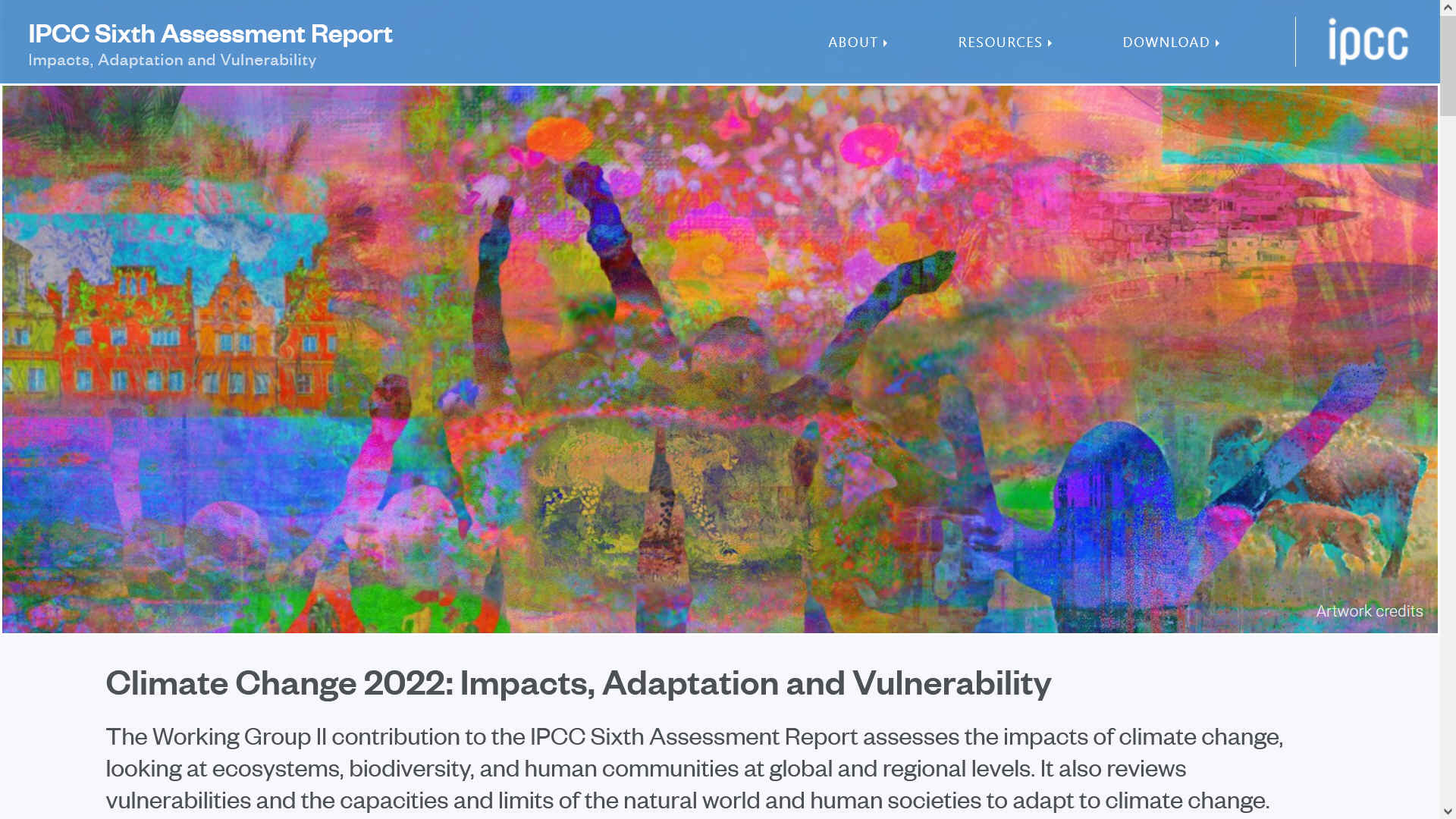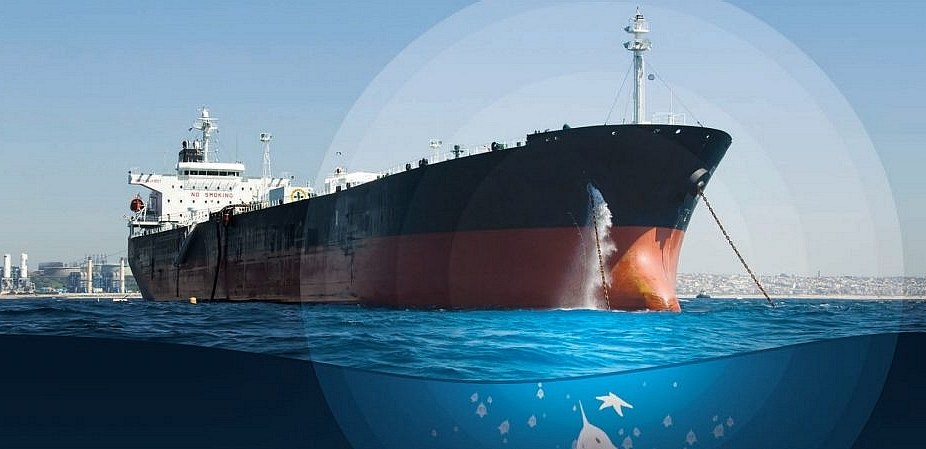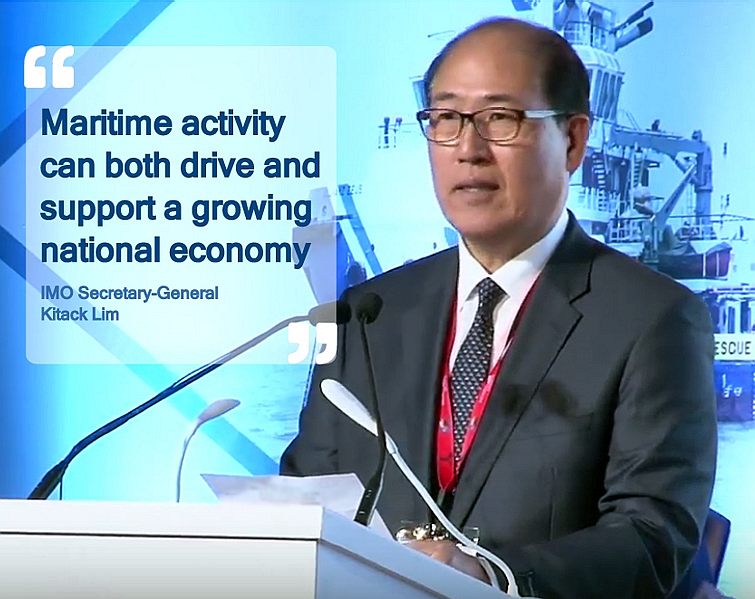
The Intergovernmental Panel on Climate Change (IPCC) is the
United Nations body for assessing the science related to
climate
change.
The IPCC prepares comprehensive Assessment Reports about the state of scientific, technical and socio-economic knowledge on climate change, its impacts and future risks, and options for reducing the rate at which
climate change is taking place. It also produces Special Reports on topics agreed to by its member governments, as well as Methodology Reports that provide guidelines for the preparation of greenhouse gas inventories. The IPCC is working on the Sixth Assessment Report which consists of three Working Group contributions and a Synthesis Report. The Working Group I contribution was finalized in August 2021 and the Working Group II contribution in February 2022.

SIX
OBSERVATIONS ON THE 2022 IPCC REPORT
1. Climate impacts are already more widespread and severe than expected.
Climate change is already causing widespread disruption in every region in the world with just 1.1 degrees C (2 degrees F) of warming.
Withering droughts, extreme heat and record floods already threaten food security and livelihoods for millions of people. Since 2008, devastating floods and storms have forced more than 20 million people from their homes each year. Since 1961, crop productivity growth in Africa shrunk by a third due to
climate
change.
Today, half the global population faces water insecurity at least one month per year. Wildfires are scorching larger areas than ever before in many regions, leading to irreversible changes to the landscape. Higher temperatures are also enabling the spread of vector-borne diseases, such as West Nile virus, Lyme disease and malaria, as well as water-borne diseases like cholera.
Climate change is also harming species and whole ecosystems. Animals such as the golden toad and Bramble Cays Melomys (a small rodent) are now extinct due to the warming world. Other animals, such as the flying fox, seabirds and corals, are experiencing mass die-offs, while thousands more have moved to higher latitudes and elevations.
2. We are locked into even worse impacts from climate change in the near-term.
Even if the world rapidly decarbonizes, greenhouse gases already in the atmosphere and current emissions trends will make some very significant climate impacts unavoidable through 2040. The IPCC estimates that in the next decade alone, climate change will drive 32-132 million more people into extreme poverty. Global warming will jeopardize
food
security, as well as increase the incidence of heat-related mortality, heart disease and mental health challenges.
For example, under a high emissions scenario, increased flood risk could lead to an additional 48,000 deaths in children under 15 years old in 2030, due to diarrhea. Species and ecosystems will face dramatic changes as well, such as mangroves failing to counteract sea level rise, declines in sea-ice dependent species and large-scale tree death.
3. Risks will escalate quickly with higher temperatures, often causing irreversible impacts of climate change.
The report finds that every tenth of a degree of additional warming will escalate threats to people, species and ecosystems. Even limiting
global warming to 1.5 degrees C (2.7 degrees F) — a global target in the
Paris Climate Agreement — is not safe for all.
For instance, with just 1.5 degrees C of global
warming, many glaciers around the world will either disappear completely or lose most of their mass; an additional 350 million people will experience water scarcity by 2030; and as much as 14% of terrestrial species will face high risks of extinction.
Similarly, if warming exceeds 1.5 degrees C, even temporarily, much more severe, often irreversible effects of
climate change will occur, such as stronger storms, longer heatwaves and droughts, more extreme precipitation, rapid
sea-level
rise, loss of Arctic sea ice and ice sheets, thawing permafrost and more. Overshooting 1.5 degrees C also increases the probability of high-impact events, such as mass forest dieback, which would turn critical carbon sinks into carbon sources.
The IPCC projects that these risks will compound one another as multiple hazards occur at the same time and in the same regions. For example, in tropical regions, the combined effects of heat and drought may trigger sudden and significant losses in agricultural yields. At the same time, heat-related mortality will increase while labor productivity decreases, so people will not be able to work harder to overcome drought-related losses. Together, these impacts will lower families’ incomes while raising food prices — a devastating combination that jeopardizes food security and exacerbates health risks like malnutrition.
4. Inequity, conflict and development challenges heighten vulnerability to climate risks.
Right now, 3.3 billion-3.6 billion people live in countries highly vulnerable to climate impacts, with global hotspots concentrated in
Small Island Developing
States, the Arctic, South Asia, Central and South America, and much of sub-Saharan Africa.
Inequity, conflict and development challenges such as poverty, weak governance, and limited access to basic services like healthcare not only heighten sensitivity to hazards, but also constrain communities’ ability to adapt to
climatic
changes. In highly vulnerable nations, for example, mortality from droughts, storms and floods in 2010-2020 was 15 times greater than in countries with very low vulnerability.
Exposure to climate impacts rose dramatically in cities since the publication of the IPCC’s Fifth Assessment Report in 2014. The fastest increases in urban vulnerability occurred across informal settlements, where precarious housing, inadequate access to basic services, and limited resources impede resilience efforts. This challenge is especially acute in sub-Saharan Africa, where 60% of the urban population lives in informal settlements, and in Asia, where 529 million people reside in these vulnerable areas.
Many rural communities also face increasing climate risks, particularly Indigenous Peoples and those whose livelihoods depend on sectors directly exposed to climate risks, such as
agriculture, fishing and
tourism. As climate impacts intensify, some households may have little choice but to move to urban centers. The IPCC projects that by 2030, extreme droughts across the Amazon will spur rural migration to cities, where Indigenous Peoples and traditional communities will likely be forced to live on the margins.
Not only do these urban and rural development patterns shape such unequal experiences of climate hazards, they also make ecosystems themselves more vulnerable to climate change. Land-use change, habitat fragmentation, pollution and species exploitation are weakening ecological resilience. And ecosystem loss, in turn, amplifies people’s vulnerability.
Cities expanding across coastal wetlands, for example, degrade ecosystems that otherwise would have helped protect shoreline neighborhoods from sea level rise,
storm surges and coastal flooding. These climate hazards can have cascading and compounding effects on residents’ health, food security, access to clean water and livelihoods, which makes them even more vulnerable to future risks.
5. Adaptation is crucial. Feasible solutions already exist, but more support must reach vulnerable communities.
At least 170 countries’ climate policies now include adaptation, but many have yet to move beyond planning into implementation. The IPCC finds that efforts today are still largely incremental, reactive and small-scale, with most focusing only on current impacts or near-term risks. A gap between current adaptation levels and those needed persists, driven in large part by limited financial support. The IPCC estimates that adaptation needs will reach $127 billion and $295 billion per year for developing countries alone by 2030 and 2050, respectively. At the moment, adaptation accounts for just 4-8% of tracked climate finance, which totaled $579 billion in 2017-18.
The good news is that existing adaptation options can reduce climate risks if they’re sufficiently funded and implemented more quickly. The 2022 IPCC report breaks new ground by analyzing various climate adaptation measures’ feasibility, effectiveness and potential to deliver co-benefits like improved health outcomes or poverty reduction.
Three assessed climate change adaptation approaches include:
Social programs that improve equity and justice: Reconfiguring social protection programs (such as cash transfers, public works programs and social safety nets) to include adaptation can lower urban and rural communities’ vulnerability to a wide range of climate risks. These measures are especially effective when coupled with efforts to improve access to infrastructure and basic services, such as clean water, sanitation and healthcare. Partnerships between governments, civil society organizations and the private sector — as well as inclusive, locally led decision-making processes — can help ensure that provision of these services improves vulnerable communities’ climate resilience.
Ecosystem-based adaptation: This approach encompasses a wide range of strategies, from the protection, restoration and sustainable management of ecosystems to more sustainable agricultural practices like integrating trees into farms, increasing crop diversity and planting trees in pastures. Ecosystem-based adaptation can reduce climate risks that many people already face — including droughts, extreme heat, floods and
fires — while also delivering co-benefits for biodiversity, livelihoods, health, food security and carbon sequestration. Meaningful collaboration with Indigenous Peoples and local communities is integral to the success of these measures, as is ensuring they’re designed to account for how future global warming will impact ecosystems.
New technologies and infrastructure: Emerging evidence suggests that coupling nature-based solutions with engineered options like flood control channels may help reduce water-related and coastal risks, particularly in cities. Access to better technologies, such as more resilient crop varieties, improved livestock breeding, or
solar and
wind
power, can also help strengthen resilience. Some of these climate adaptation responses, however, can be harmful if poorly designed or implemented inappropriately. Expanding irrigation systems, for example, can address short-term climate risks, but can also drain scarce groundwater reserves.
6. But some impacts of climate change are already too severe to adapt to. The world needs urgent action now to address losses and damages.
With the 1.1 degrees C of global warming the world is already experiencing, some highly vulnerable people and ecosystems are beginning to reach the limits of what they can adapt to. In some regions, these limits are “soft” — effective adaptation measures exist, but political, economic and social challenges hinder implementation, such as limited access to finance. But in others, people and ecosystems already face or are fast approaching “hard” limits to adaptation, where climate impacts are so severe that no existing adaptation measures can effectively prevent losses and damages. For instance, some coastal communities in the tropics have lost entire
coral reef ecosystems that once helped sustain their food security and livelihoods. Others have had to abandon low-lying neighborhoods and cultural sites as sea levels rise.
Whether facing soft or hard limits of climate adaptation, the result for communities is devastating and oftentimes irreversible. These losses and damages will only increase as global temperatures rise. For instance, if the world warms beyond 1.5 degrees C, communities that depend on glacial and snow melt will face water shortages to which they cannot adapt. At 2 degrees C (3.6 degrees F), the risk of simultaneous failures in maize production across key growing regions will increase significantly. And above 3 degrees C (5.4 degrees F), parts of southern Europe will experience dangerously high summertime heat.
Through its assessments, the IPCC determines the state of knowledge on climate change. It identifies where there is agreement in the scientific community on topics related to climate change, and where further research is needed. The reports are drafted and reviewed in several stages, thus guaranteeing objectivity and transparency. The IPCC does not conduct its own research. IPCC reports are neutral, policy-relevant but not policy-prescriptive. The assessment reports are a key input into the international negotiations to tackle climate change. Created by the United Nations Environment Programme (UN Environment) and the World Meteorological Organization (WMO) in 1988, the IPCC has 195 Member countries. In the same year, the UN General Assembly endorsed the action by WMO and UNEP in jointly establishing the
IPCC.

IPCC
WORKING GROUPS & TASK FORCE
IPCC assessments and special reports are prepared by three Working Groups, each looking at a different aspect of the science related to climate change: Working Group I (The Physical Science Basis), Working Group II (Impacts, Adaptation and Vulnerability), and Working Group III (Mitigation of Climate Change). The IPCC also has a Task Force on National Greenhouse Gas Inventories, whose main objective is to develop and refine a methodology for the calculation and reporting of national greenhouse gas emissions and removals. The Working Groups and Task Force handle the preparation of reports, selecting and managing the experts that work on them as authors. The activities of each Working Group and the Task Force are supported by their Technical Support Units
(TSU).
CONTACT IPCC
No contact details found!
LINKS
& REFERENCE
https://facebook.com/IPCC
https://twitter.com/IPCC_ch
https://linkedin.com/company/ipcc
http://slideshare.com/IPCCGeneva
https://instagram.com/IPCC
https://www.ipcc.ch/
Please use our
A-Z INDEX to
navigate this site


